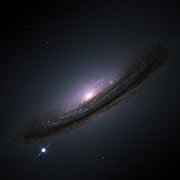Measuring the age and size of the Universe
The search for Cepheids
 |
| Spiral galaxy NGC 4603 containing Cepheids being used for distance measurements. |
The top ranked scientific justification for building Hubble was to determine the size and age of the Universe through observations of Cepheid variables in distant galaxies. This scientific goal was so important that it put constraints on the lower limit of the size of Hubble's primary mirror. Cepheids are a special type of variable star with very stable and predictable brightness variations. The period of these variations depends on physical properties of the stars such as their mass and true brightness. This means that astronomers, just by looking at the variability of their light, can find out about the Cepheids' physical nature, which then can be used very effectively to determine their distance. For this reason cosmologists call Cepheids 'standard candles'.
Astronomers have used Hubble to observe Cepheids with extraordinary results. The Cepheids have then been used as stepping-stones to make distance measurements for supernovae, which have, in turn, given a measure for the scale of the Universe. Today we know the age of the Universe to a much higher precision than before Hubble: around 13.7 billion years.
|
"We certainly live in exciting times. Hubble has made enormous progress possible within cosmology. Today we have a much more unified cosmological picture than was possible even five years ago when people were talking of ‘The Cosmology in Crisis’. We have seen a dramatic change from misery to glory!" Gustav A. Tammann |
The expansion of the Universe
 |
| Supernova 1994D (lower left). |
One of Hubble's initial 'core' purposes was to determine the rate of expansion of the Universe, known to astronomers as the "Hubble Constant". After eight years of Cepheid observations this work was concluded by finding that the expansion increases with 70 km/second for every 3.26 million light-years you look further out into space.
Hubble's sharp vision means that it can see exploding stars, supernovae that are billions of light years away and difficult for other telescopes to study. A supernova image from the ground usually blends in with the image of its host galaxy. Hubble can distinguish the light from the two sources and thus measure the supernova directly.
For many years cosmologists have discussed whether the expansion of the Universe would stop in some distant future or continue ever more slowly. From the new supernova results it seems clear that the expansion is nowhere near slowing down. In fact, due to some mysterious property of space itself, called dark energy, the expansion is accelerating and will continue forever. This surprising conclusion came from combined measurements of remote supernovae with most of the world’s top-class telescopes, including Hubble. Furthermore recent supernova results indicate that cosmos did not always accelerate, but began accelerating when the Universe was less than half its current age.
The discovery of the accelerating expansion of the Universe led to three astronomers, Saul Perlmutter, Adam Riess and Brian Schmidt, being awarded the 2011 Nobel Prize in Physics.
|
"Hubble gave us the distance measurements of the first four supernovae that made us realise something was wrong with our present understanding of the Universe. Even though the definite proof that the Universe is accelerating came later, we could not reconcile our Hubble observations with a Universe where the expansion is slowing down." Bruno Leibundgut |
Related images and videos
- Interview: Astronomer Bruno Leibundgut talks about the discovery of the accelerating expansion of the cosmos
- Images of cepheids in nearby galaxies
Related news releases
- Astronomers take a step towards revealing the Universe’s biggest mystery (2010)
- Hubble confirms cosmic acceleration with weak lensing (2010)
- Cosmic lenses support finding on faster than expected expansion of the Universe (2017)
- Hubble observes first multiple images of explosive distance indicator (2017)